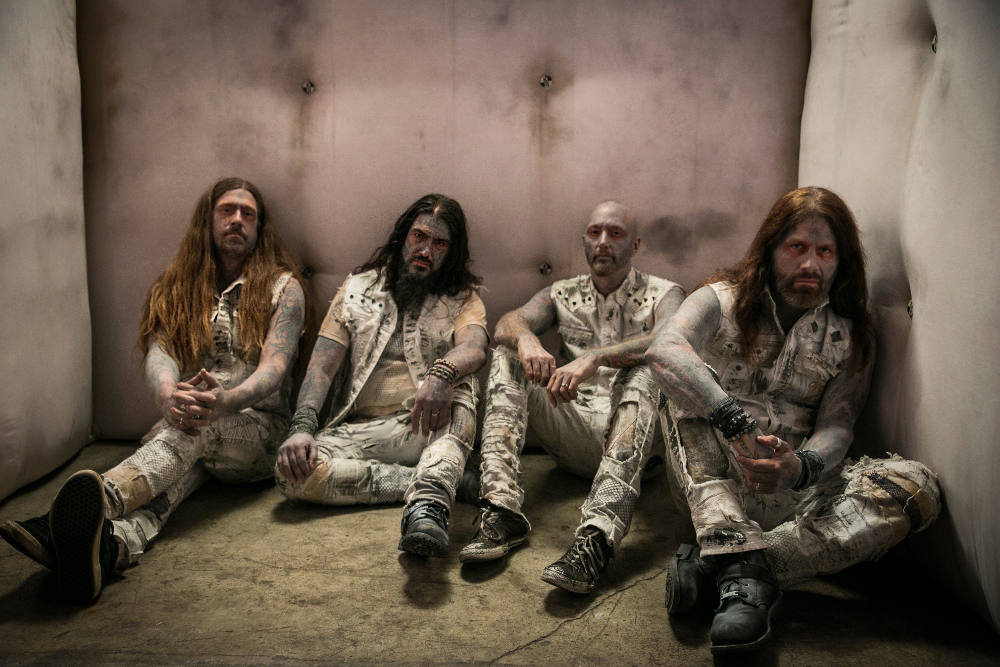“It’s very much a Machine Head record,” Flynn says. “There’s some really heavy shit there, but there’s also a lot of melody and a lot of groove. There’s not a lot of thrashy stuff. I’ve been telling people it’s the record that could have followed The Burning Red. And there’s no reason: there was no plan to do that. There was no discussion, we never had any words, we just started writing and the stuff that was getting our dicks hard was the more grooving, more melodic stuff! Some bands do that – a lot of bands plan things out before they start writing but we’ve never done that.
“I think the way that we look at it is there’s a journey that we’re going on, and we don’t know where that journey ends but that’s part of the fun and the challenge and the elation of writing music. And every record is like that and it’s the first step of a journey where you don’t know where you’re going …yet you kind of do because, especially being nine albums deep, it’s always going to be my right hand, it’s always going to be my voice, it’s always going to be Dave on the drums, it’s always going to be Phil’s leads, but it can go so many places, and I think you change, right? You change as people from who you were three years ago when you wrote the last record. You grow and your life experiences are totally different. You take all of those things and you apply it to what you’re doing now and that’s the record you end up with.”
Flynn’s main guitar for the sessions – and his main recording guitar for years – is made by a German luthier, Dragan Milosevic. During our Skype interview, Flynn zips off camera for a second to grab a black Flying V. “This is my main live guitar, made by the same guy,” he says. “It’s 27 3/4” scale, so it’s an extra-baritone. It’s got six strings, two pickups. My recording guitar just has the one pickup, an EMG 81. The guitar I record with doesn’t even have a toggle switch, just pickup and volume knob, nothing in the way of taking tone away. I like that. I’ve got a raw, unbleached bone nut, so it’s still got the oil in there and it’s got a killer sound. These are all mother-of-pearl Love-Death inlays here.” Flynn points to a massive divot near the neck pickup on the bass side. “See this here? This hole I can put my finger in? That’s years of downpicking right there! It’s matte black, which is cool. Both guitars are back-routed, and I added a pickguard to the recording one.
“When I originally got it, it was a plain black guitar. The difference is when you get a regular Flying V, all of the treble side is routed out and they use a pickguard to cover it. But you’re routing out a huge amount of wood, a tonne of wood to do that, and that’s a lot of tone that you’re removing because the pickup is resonating on everything around it. The other guitar is Brazilian Rosewood and it’s a fucking beast! It’s the heaviest guitar I’ve ever owned. It’s almost twice the weight of every other guitar I have!”
Flynn’s picking-hand strength is legendary – as evidenced by that massive gouge ripped out of the wood of his guitar – and it was developed over time from influences such as James Hetfield and Eddie Van Halen, whose unconventional pick grip led Flynn to using his middle finger as well as his index and thumb to hold the pick. This gives you a much chunkier and more consistent upstroke. “You get that killer scrape,” he says. “So much of that downpicking tone is that killer scrape that makes it sound tight, and holding it with three fingers is how it gets really tight. When you’re doing tremolo picking or fast thrashy picking, that ‘up’ becomes extra strong because of that extra finger there. That was a big part of the way I made my style.”
But one of Flynn’s even more recognisable techniques is his clever use of harmonics, and that comes from a particularly interesting place. “When I started playing, I always loved bands like Black Sabbath but I also loved shit like DRI and Celtic Frost that were like sludgy punk rock, and they’d always do this ‘Baaah-eeeeeeeeee’ – they’d hit a chord and then they’d get feedback. And I had this little amp about four inches by four inches, and I couldn’t get feedback! So while I’m trying to learn these Celtic Frost and DRI songs I’m like, ‘How the fuck do you make that sound?’ And so I hit a harmonic one time and I was like, ‘Oh that must be that sound!’ I didn’t realise that sound was feedback, so I’d learn songs and hit a harmonic for the feedback, and I learned this wrong way, but then that wrong way became part of our style, like the downpicking and that picture of Eddie Van Halen in my room.”
Catharsis is out Friday January 26 via Nuclear Blast Records.

